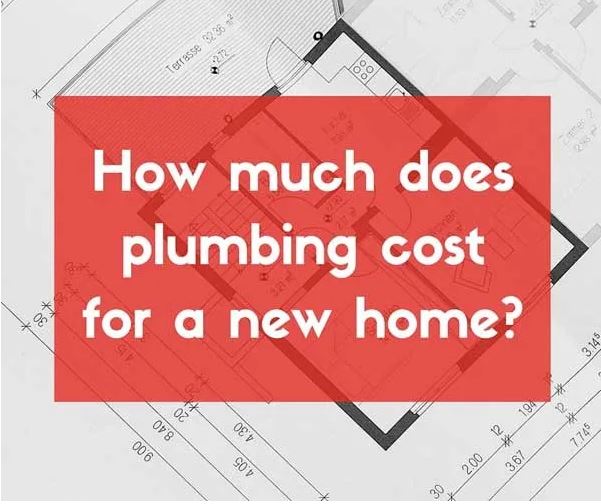Plumbing Costs For A New Home
Anyone who has built a new home before will know that it can be a very complex and stressful undertaking. As North Shores & Northern Beaches plumbers, we’ve seen our fair share of customers who’ve had their dream project quickly turn into a nightmare thanks to budget blow-outs! It pays to have a very clear idea of all your expenses from the beginning, and the cost of plumbing for your new home is one of the key things you’ll need to consider.
We always recommend getting quotes from several licensed plumbers early in the project planning so you know what you’re in for, and so you can compare apples with apples. You’d be surprised how much the quotes can vary and while cost shouldn’t be the only factor you consider, you do want to make sure you’re getting the best bang for your buck. Do you want to understand the factors that affect the plumbing costs? Then this article will be extremely helpful for you especially if you have a brand new home in Australia. We will provide estimates and valuable advice that will help you make an educated choice
Understanding the Basics of Plumbing in a New House
Before we get into the cost, let’s look at the basic elements of plumbing within a brand new home. Plumbing systems comprise pipes as well as fittings, fixtures that provide drinking water that is clean, and eliminate the waste. The plumbing system in a brand new home usually comprises:
A) Water Supply System: It consists of pipes that supply clean water from the main supply to different outlets, such as faucets, toilets, and showers.
B) Drainage System: This is the system responsible for the disposal of the waste, from showers, sinks and toilets into the septic tank or sewer.
C) Gas plumbing: If your home is dependent on gas for cooking, heating or for other reasons the gas plumbing system will be put in place in a separate location.
What a quote for the cost of plumbing your new home should include:
To save yourself from getting a nasty surprise when those quotes come through, make sure you understand the different elements that your plumber will include in their estimate. The cost of plumbing a new home will be a combination of the price of the materials needed and the estimated number of labour hours required. Labour costs will be charged at an hourly rate, usually between $100-$150 depending on the plumber. To make sure you’re getting an accurate quote, provide your potential plumbers with the architectural drawings and any other information about the project that you have. Things such as the number of bathrooms, the type of water heating system, and the number of fixtures that need to be installed in your new home will all affect the final costs.
Size doesn’t matter as much as you think:
Many people make the mistake of thinking that the size of their new home will be the biggest factor in determining the cost of the plumbing. While the square meters will make some difference, for example, a larger home will need more piping, it is often not as important as you would think. Other considerations such as the number of fixtures you need, and the complexity of the systems you are installing, will play a bigger role in determining the final cost for new home plumbing. In many cases, the installation of plumbing in smaller homes can actually cost more because they require more complex piping systems, which will increase the labour hours.
Cost for Fixtures:
Usually, people building a new home will want to choose and purchase their own major fixtures, such as their bathtubs, showers, taps and sinks. However, If you do want any advice or assistance with choosing these things, our experienced Sydney plumbers can help. We have plenty of expert knowledge about the best fixtures on the market, and we can even purchase them for you if you like. If you would like us to help with this part of your project, simply let us know and we’ll include the costs in our final quote.
The Extras:
Other materials that will affect the cost of plumbing in your new home include pipes, drains, shut off valves, vents, and p-traps. These items will all be provided by your plumber and should be included in their quote. The plumbing quotes should also include the cost for any extra materials needed to complete the job, such as acid paste, propane for soldering copper pipes, PVC cement, and primer.
Installation:
Because the installation of plumbing happens over a number of stages, your plumber will be one of the first and last people onsite at your new home build. Early on in the building project, you’ll need to have your plumber connect the main drain pipe to the septic tank or wastewater system – this is usually done before the concrete foundation is poured. Installation of your fixtures such as toilets and showers are usually done later in the project, once all tiling work has been done. Make sure that quotes you receive from any potential plumbers includes the labour hours for all stages of the project, so you do not get any surprises when the final costs for plumbing your new home rolls in!
Factors Affecting Plumbing Costs
The price of plumbing for a brand new house in Australia can be a bit different because of a variety of factors:
House Size: More homes need more plumbing supplies and labour that can increase the total cost.
Design Complexity: Expensive designs that have multiple kitchens, bathrooms, or water features for outdoor use may increase the cost of plumbing.
Material Selection: The selection of the plumbing material, like copper, PVC, or PEX will impact the total cost. Copper is durable, but expensive, however, PVC and PEX are more affordable.
Location: Construction costs can vary according to the region in Australia due to differences in costs for materials and labour.
Labour Costs: The cost of labour for plumbing will vary depending on the extent of the project and the expertise of the plumbing experts.
Additional Features: Plumbing for outdoor kitchens, swimming pools or specialised water systems will increase the total cost.
Estimated Plumbing Costs for a New House
In 2021, the most expensive plumbing cost for a brand new home in Australia was around $10,000 to around AUD 220,000. Keep in mind that these estimates are only estimates and could fluctuate based on the factors previously mentioned. To give a more precise breakdown:
Water Supply Plumbing
The price of constructing pipes for water supply, fittings and fixtures can vary from AUD 4,000 to $10,000.
Drainage Plumbing
establishing the drainage system which includes traps, pipes and vents, could cost anywhere from AUD 4,000 to AUD 8000.
Gas Plumbing
If your home has to be fitted with gas pipes, anticipate an additional charge of AUD 2,000-AUD 5 000.
Tips to Manage Plumbing Costs
Now you know the extent of the possible costs. Here are some useful tips to help you control the plumbing costs of building your house:
Plan ahead
Planning early lets you make well-informed choices, avoiding last-minute adjustments which can cost you money.
Work with experienced plumbers
Hiring experienced and licensed plumbers could be more expensive initially but will guarantee top quality work, reducing the likelihood of future repairs and costs.
Choose water-efficient fixtures
The water-efficient faucets, toilets and showers not only conserve water, but they also reduce your costs for utilities over the long term.
Select the right materials
You must balance quality and price by choosing durable and affordable plumbing materials.
Consolidate the Plumbing Locations
Reduce the number of kitchens and bathrooms in your home, as each adds to the cost and complexity of plumbing.
Regular Maintenance
After your plumbing system is installed, you should invest regularly in maintenance that will spot and address minor issues before they get out of hand.
Water-efficient fixtures
These fixtures are designed to cut down on water consumption without affecting the performance. Fixtures are becoming more popular with the rise of sustainable homes as they help in conserving water. Here are a few common kinds of water-efficient fixtures as well as their advantages:
Water-Efficient Toilets
Traditional toilets consume a substantial amount of water per flush, and can be a waste of gallons of water per day. Toilets that are water-efficient, like dual-flush toilets or low-flow toilets are designed to reduce water consumption while eliminating waste.
Low-Flow Toilets
They consume around litres of water per flush, as compared with older models, which consume 3.5 to 7 gallons (13 to 26 litres). Some ultra-low-flow models use less, averaging 1.28 Gallons (4.8 litres) per flush.
Dual-flush Toilets
Dual-flush toilets come with two options for flushing: a half-flush option for liquid waste and a full flush for solid waste. Dual flush is mostly used as it reduces the use of water. How can it do that? It lets users select the right amount of water to flush the kind of waste they are dealing with.
Water-Efficient Faucets
Standard faucets can run at an average of 2.2 Gallons (8.3 Litres) per minute, or greater, which can lead to a lot of water wasted in everyday activities like dishwashing or hand washing. Water-efficient faucets employ aerators as well as flow restrictors to limit the flow of water, while ensuring adequate pressure.
Aerators
Aerators are devices that mix air and water. This helps in creating a steady flow, while using less water. One of the best features of aerators is that they are easy to install and they can cut down on water usage by 50 percent without sacrificing performance.
Flow Restrictors
These devices are used to restrict the amount of water flowing through the faucet. Let’s say for example you need to wash only your fingers rather than the whole hand, a full flow at this point will be wastewater because you do not actually require that amount.
Water-Efficient Showerheads
Traditional shower heads may make use of 2.5 Gallons (9.5 Litres) or more every minute, resulting in excessive water consumption in showers. Shower Heads that are water-efficient have been designed to give you a pleasant showering experience, while making use of less water.
Showerheads with low-flow
They usually make use of 1.5 to 2 gallons (5.7 to 7.6 litres) per minute, which results in significant water savings over conventional models.
High-Efficiency Shower Heads
Showerheads incorporate cutting-edge technologies such as an air infusion system or pulsating patterns of spray to provide an enjoyable shower experience using less water.
Water-Efficient Washing Machines
Traditional top-loading washers can consume up to 40 Gallons (151 Litres) of water for each load. However, water-efficient models dramatically reduce the use of water.
Front-loading Washing Machines
Front-loading washing machines are generally more efficient over top-loading models. They use less water because they are rolling clothes through a smaller amount of water which results in a lower consumption of water per load.
Water-Efficient Dishwashers
Older dishwashers may use 10 gallons (38 litres) or more per cycle. Water-efficient dishwashers make use of advanced water-saving technology to reduce water use.
Dishwashers that are Energy Star-rated
Find dishwashers that have the Energy Star label, as they are rated to meet the strictest efficiency standards that include water consumption.
Benefits of Water-Efficient Fixtures
Installation of fixtures that are water efficient provides many benefits:
Water savings
Water-efficient appliances dramatically reduce the use of water in homes and help conserve this precious resource while helping to ensure sustainability for the environment.
Lower Utility Costs
By reducing the use of water homeowners can cut down on water bills, which makes their homes more affordable.
Environmental Impact
In using less water households reduce their environmental footprint and can help reduce water shortage issues.
Incentives and Compliance
Certain regions installing water-efficient fixtures could be required to comply with the water conservation requirements. Additionally certain utilities and organisations offer incentives or rebates for the installation of water-efficient fixtures to encourage the use of these fixtures.
The most important thing to remember when planning the plumbing for your new home is that this is absolutely not a DIY project. Only an experienced, licensed plumber who knows all the standards and regulations relevant in your state should be hired for such a project. It’s far better to pay a higher rate and know that your plumbing work is top-quality, than to be left shelling out for repairs down the track thanks to a dodgy plumber! If you’re planning a new home build and would like to talk to our team of experienced plumbers or request a quote, give the team at Tai Irwin Plumbing a call today.






